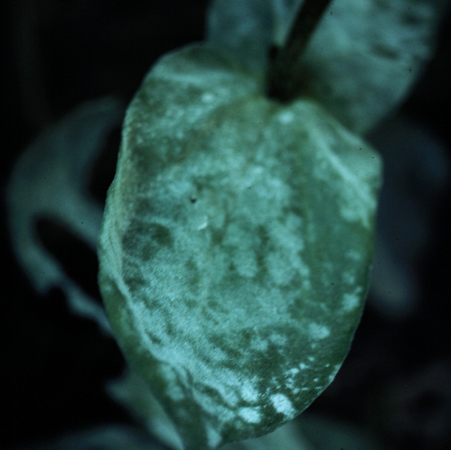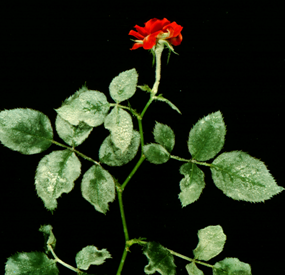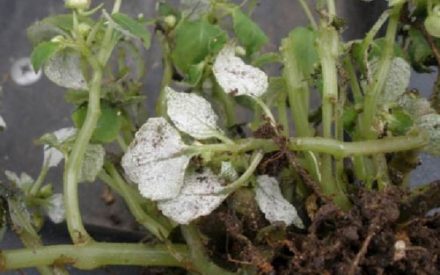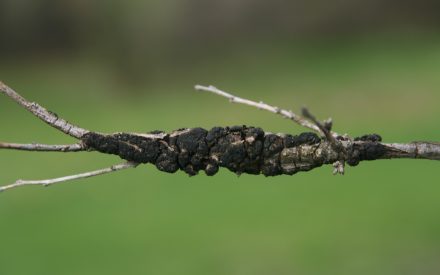
What is powdery mildew?
Powdery mildews are diseases that occur on the above-ground parts (especially the leaves) of many herbaceous ornamentals, as well as deciduous trees and shrubs, indoor houseplants, and many agricultural crops. Conifers are not affected by these diseases.
What does powdery mildew look like?
The name of these diseases is descriptive. The upper and lower surfaces of leaves, as well as stems of infected plants, have a white, powdery appearance. They look as though someone has sprinkled them with talcum powder or powdered sugar.
Where does powdery mildew come from?
Powdery mildews are caused by many closely related fungi that survive in plant debris or on infected plants. These fungi are fairly host specific. The powdery mildew fungus that infects one type of plant (e.g., phlox) is not the same powdery mildew fungus that infects another (e.g., lilac). However, if you see powdery mildew on one plant, then weather conditions (high humidity) are favorable for development of powdery mildews on a wide range of plants.
How do I save a plant with powdery mildew?
Don’t panic! For many plants, powdery mildews are cosmetic, non-lethal diseases. For other plants (e.g., phlox, beebalms, zinnia), powdery mildews can cause severe leaf loss.
When a highly valued plant has had severe leaf loss due to powdery mildew for several years, you may want to consider using a fungicide for control. Fungicides containing chlorothalonil, copper, mancozeb, myclobutanil, triadimefon, sulfur or thiophanate-methyl are registered for powdery mildew control. A combination of baking soda (1½ tablespoons) and a light weight (i.e., paraffin-based) horticultural oil (3 tablespoons) in water (1 gallon) has also been shown to be effective. Most products should be applied every seven to 14 days from bud break until humid weather subsides. DO NOT use myclobutanil, triadimefon, or thiophanate-methyl as the sole active ingredient for all treatments. If you decide to use one of these active ingredients, alternate its use with at least one of the other listed active ingredients to help minimize problems with fungicide-resistant strains of powdery mildew fungi. DO NOT alternate myclobutanil and triadimefon as these active ingredients are chemically related. Be sure to read and follow all label instructions of the fungicide(s) that you select to ensure that you use the product(s) in the safest and most effective manner possible. Also consider pretesting any product that you decide to use on a small number of leaves or plants before treating a larger area to make sure there are no toxic effects, particularly when treating during warmer weather.

How do I avoid problems with powdery mildew in the future?
Consider buying plant varieties that are powdery mildew resistant. This will not guarantee that your plants will be powdery mildew free every year, but should result in less severe disease when it occurs. Reduce the humidity around your plants by spacing them further apart to increase air flow. Be sure not to over-water as this can lead to higher air humidity as well. Finally, at the end of the growing season, remove and destroy any infected plant debris as this can serve as a source of spores for the next growing season. You can burn (where allowed by local ordinance), bury or hot compost this material.
For more information on powdery mildew:
Contact the University of Wisconsin Plant Disease Diagnostics Clinic (PDDC) at (608) 262-2863 or pddc@wisc.edu.
Authors: Brian Hudelson, UW-Madison Plant Pathology
Last Revised: 03/01/2024
D-number: D0084
References to pesticide products in this publication are for your convenience and are not an endorsement or criticism of one product over similar products. You are responsible for using pesticides according to the manufacturer’s current label directions. Follow directions exactly to protect the environment and people from pesticide exposure. Failure to do so violates the law.
Thanks to Bill Halfman, Laura Jull, Patti Nagai and Amy Sausen for reviewing this document.
A complete inventory of UW Plant Disease Facts is available at the University of Wisconsin-Madison Plant Disease Diagnostics Clinic website: https://pddc.wisc.edu.
Send a Plant Sample for Analysis
Be cautious when self-diagnosing plant health issues. Very few diseases can accurately be diagnosed by eye.
Contact the UW Plant Disease Diagnostics Clinic (PDDC), and for a small fee, clinic staff can examine a plant, determine the cause of the disease/disorder, and provide advice on how to control or prevent the issue.
Download Article





 Powdery Mildew - Trees and Shrubs
Powdery Mildew - Trees and Shrubs Impatiens Downy Mildew
Impatiens Downy Mildew Iris Severe Mosaic
Iris Severe Mosaic Strategies for Identifying and Managing Plant Diseases
Strategies for Identifying and Managing Plant Diseases


